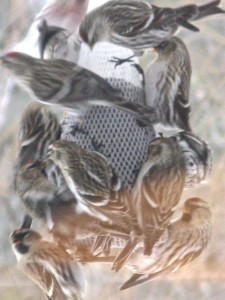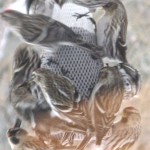 In another month or two, the families of birds who have kept us company through the long winter will disappear once again into the canopies of green. Black-capped chickadees, tufted titmice, red-breasted nuthatches, cardinals, blue jays, junkos, woodpeckers, and a variety of finches — these birds of winter are often the only signs of life in an otherwise frigid and monotone landscape. Chattering at the birdfeeders or swooping in long, graceful swags across the fields, they have brought movement, color, and song into the darkest months of the year. In the spring and summer, we see and hear them only in snatches — a flash of blue in the thicket by the stream or the cardinal’s cheer cheer cheer somewhere high in the hemlocks.
In another month or two, the families of birds who have kept us company through the long winter will disappear once again into the canopies of green. Black-capped chickadees, tufted titmice, red-breasted nuthatches, cardinals, blue jays, junkos, woodpeckers, and a variety of finches — these birds of winter are often the only signs of life in an otherwise frigid and monotone landscape. Chattering at the birdfeeders or swooping in long, graceful swags across the fields, they have brought movement, color, and song into the darkest months of the year. In the spring and summer, we see and hear them only in snatches — a flash of blue in the thicket by the stream or the cardinal’s cheer cheer cheer somewhere high in the hemlocks.
Here’s a poem about finches by Deborah Digges whose work seems to me to only deepen with meaning and beauty since her untimely death seven years ago. I believe that the final lines are set in the Galapagos where Darwin gathered specimens for what would become his great work on evolution.
DARWIN’S FINCHES
by Deborah Digges, 1950 – 2009
1
My mother always called it a nest,
the multi-colored mass harvested
from her six daughters’ brushes,
and handed it to one of us
after she had shaped it, as we sat in front
of the fire drying our hair.
She said some birds steal anything, a strand
of spider’s web, or horse’s mane,
the residue of sheep’s wool in the grasses
near a fold
where every summer of her girlhood
hundreds nested.
Since then I’ve seen it for myself, their genius—
how they transform the useless.
I’ve seen plastics stripped and whittled
into a brilliant straw,
and newspapers—the dates, the years—
supporting the underweavings.
2
As tonight in our bed by the window
you brush my hair to help me sleep, and clean
the brush as my mother did, offering
the nest to the updraft.
I’d like to think it will be lifted as far
as the river, and catch in some white sycamore,
or drift, too light to sink, into the shaded inlets,
the bank-moss, where small fish, frogs, and insects
lay their eggs.
Would this constitute an afterlife?
The story goes that sailors, moored for weeks
off islands they called paradise,
stood in the early sunlight
cutting their hair. And the rare
birds there, nameless, almost extinct,
came down around them
and cleaned the decks
and disappeared into the trees above the sea.



…a lovely poem, thank you
and just a local notice: the snowdrops are up, there is a smattering of opening witch hazel around and by next week the forsythia should be ready for it’s seasonal glory throughout Central Park..
Thank you for the progress report from Central Park, Annette. Can’t wait to get there!
Liza, what a beautiful and moving poem, it brought tears to my eyes. Now I know what to
do with the girls hair after cleaning their brushes… Thank you for sharing this.
It was so fun counting all those busy birds at your feeder on that chilly -15 degree
morning a few weeks ago at La Ferme. Looking forward to all that spring brings.
Best Love, Kate
Digges was one of 10 children — there were six girls — and her poems are filled with her family — overtly and otherwise. I think that’s another reason why I love her work.
A wonderful poem. I was running the other day and found myself surrounded by three cardinals. I looked for the other mate but couldn’t find it: perhaps these were more scandalous than most of their breed.
Scandalous cardinals! Though I guess that’s nothing new, at least in the world of humans.
Lovely poem – I bet the birds also use our cat’s hair when we brush her and let the hairs float off in the wind.
I bet they do — what a nice idea. I’m going to start letting Bix’s fur fly, too!
Liza,
how beautiful: the poem reminds me of the finches in Ghent; nature’s using the
apparently useless, and from a tiny hair to the spacious final image of disappearing into trees above the sea! Reassuringly metaphysical.
Yes, I keep thinking about the final line, as well. The trees above the sea. The rest of the poem is pretty grounded, then, suddenly — whoosh! — we’re off!
Aaahhh I love this poem – especially the way it weaves imagery of the “nest” she and her sisters grew up in with the nesting birds and their resourceful brilliance. And here’s to letting the hair of spring fly! There are both rhyme and reason linking spring and the loss of all that winter dog and cat fur, winter deer and horse coats and the need for building materials! Birds have so much to teach us about the connectedness of all things…
Thank you Liza!
What lovely observations, Meg! Thank you.